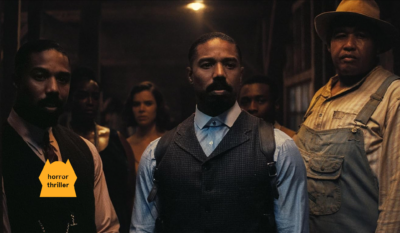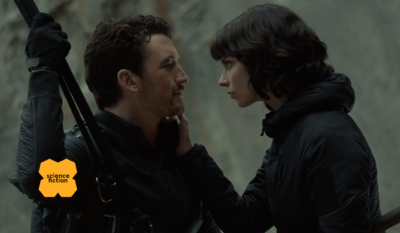A group of journalists and war photographers trek from New York to Washington, D.C. while the United States is in the throes of a civil war


Writer-director Alex Garland's Civil War is an all-out assault on the senses that immerses you in a war zone that isn't just close to home, it is home. When it focuses on the sheer terror and brutality of war — graphic images mixed with the worst of human tendencies — and the emotional and moral complexities of being a war photographer, the movie is nothing short of engrossing. However, whenever it deigns to say anything specific about the current state of society and culture in the United States it feels misguided. Mixed with opaque characters and uneven writing, Civil War feels at war with itself.![]()
Civil War is in theaters now.

The first shot of Alex Garland's Civil War is of the President of the United States, played by Nick Offerman, in extreme closeup. He says, “We are closer than ever to,” then pauses. You assume he's going to say “civil war.” Instead, he says, “to victory.” It's perhaps Garland's cheeky way of quickly setting up the movie as a cautionary tale. The United States is closer than it ever has been to civil war, especially when he wrote this film four years ago. And it's clear that Garland came up with this story as a response to what he was seeing around him in this country, even if the movie itself takes place in a somewhat fictional dystopia.
ADVERTISEMENT
While he keeps many of the specifics of what led to the war and how we got to the point that rebellion forces are on the precipice of toppling Washington, D.C. we get a vague understanding of the state of play. The Western Forces are a coalition of states allied with California and Texas that have seceded from the nation and presumably were fed up with a president that dismantled the FBI, sought and won a third term and used drones on American civilians. I'm sure you can imagine who he's referring to.
It's part of the fallacy of Civil War. While Garland avoids specifics as a means to focus in on the general themes, he includes enough for us to understand that the story misunderstands what it's saying.
It's the trouble of setting an allegory like this in a real-life environment. The benefit is that it adds a layer of relatability and terror at the prospect of an event like this hitting so close to home. Graphic images of war and violence on the streets of New York City or Washington, D.C. are a chilling reminder of what is going on in the day-to-day lives of some around the world. When the movie hones in on the unabashed brutality of war and the complexity of being a war correspondent, the movie's transparency enhances all of those feelings. But whenever it attempts to bring in real-world artifacts — a line that mentions a fictional “antifa massacre” is particularly jarring — it immediately takes you out of the movie.
But if the mechanics of its world take you out, the story pulls you in and doesn't let go. Kirsten Dunst plays Lee Smith, a renowned war photographer on the hunt for the holy grail: a photo of the president. Along with her journalist colleague Joe (Wagner Moura), her mentor Sammy (Lady Bird‘s Stephen McKinley Henderson) and aspiring young photographer Jessie (Priscilla‘s Cailee Spaeny) she makes the long, dangerous trek through war-torn land and raging battles from New York City to the nation's capital.
Along the way, they encounter the monstrosities of war including a suicide bombing that nearly takes both Lee and Jessie out — of course, a second after getting her bearings Lee is up taking photos of the carnage — and a shootout between rebel forces and the U.S. military.
Both scenes are violent, graphic and immersive. Like you're being surrounded on all sides by gunfire, smoke and the smell of death. Interestingly, Garland doesn't sensationalize these images. Even when we watch people dying, the image is objective — just as Lee sees them. That isn't to say she doesn't care, she believes that the work is a necessity.
As they continue to make their way through the country, encountering people fighting for both sides and those caught in the middle, we learn what drives each of the characters. However, the screenplay never allows us too close. Almost like we're just seeing them in a still photograph without the context of what come before or what is happening around them. Perhaps it's an intentional choice. However, it left me unable to become emotionally invested in their journeys.
When barnburner scenes come along like an encounter with a group of soldiers that goes awry — led by Jesse Plemmons in yet another role that proves he's one of the great character actors working today — there's suspense because of the situation, but not because we're afraid for our characters. As Plemmons's unnamed soldier goes down the line of our hero journalists asking what state they're from, there's a palpable amount of tension. It's moments like it when Civil War fully meets expectations. But then it immediately fades away because we're not emotionally connected to the characters enough to have actually cared about the outcome.
When Civil War is great, it is magnificent. Especially the climactic final assault on the White House by rebel forces that could've been a short film in itself. Though it's chaotic, Garland guides us through the carnage to tell us a nearly wordless story about the pursuit of the truth, the melancholic thrill of destruction and even the out-of-touch way that our leaders see the country — like their actions have no consequences. It is one of the best action scenes in a war movie in recent memory and shows he trusts the audience enough to understand what he's trying to tell us. However, when it starts to tell instead of show, Civil War feels at war with itself.
ADVERTISEMENT
More movies, less problems
- Jordan Peele Unleashes the First Trailer for ‘HIM'
- ‘Sinners' is the best movie of the year | movie review
- Romantic sci-fi thriller ‘The Gorge' hits its mark | movie reivew
Hey! I'm Karl. You can find me on Twitter and Letterboxd. I'm also a Tomatometer-approved critic.
💌 Sign up for our weekly email newsletter with movie recommendations available to stream.
ADVERTISEMENT
Hey, I'm Karl, founder and film critic at Smash Cut. I started Smash Cut in 2014 to share my love of movies and give a perspective I haven't yet seen represented. I'm also an editor at The New York Times, a Rotten Tomatoes-approved critic, and a member of the Online Film Critics Society.

